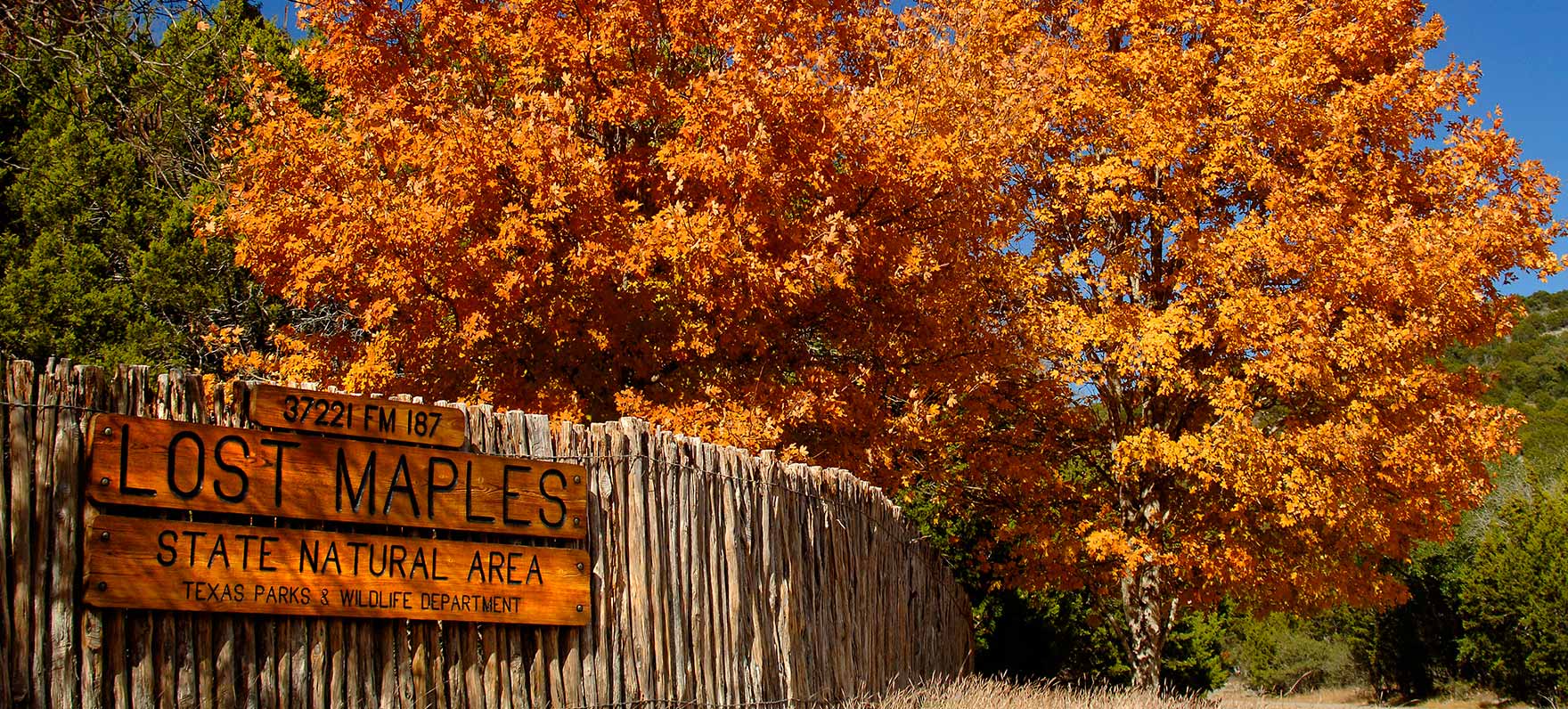“Seeing some yellow and a little red”
That was the foliage report posted on the Lost Maples State Natural Area Facebook page on October 29, 2018. Anyone who has visited this state park in November understands the excitement and anticipation in those words. This Texas state park, located north of Vanderpool on the Sabinal River, protects a stunning stand of Uvalde Bigtooth Maples whose dazzling fall colors have attracted sightseers for generations and November is prime time for their autumnal show.
About those trees
The Uvalde Bigtooth Maple is the western relative of the Sugar Maple. It is native to the sheltered canyons of the Edwards Plateau, the Lampasas Cut Plains, and the high country of the Trans-Pecos. Texas Parks & Wildlife magazine’s “In Search of Bigtooth” addressed how these sheltered canyons contributed to the trees’ survival:
“The ancestors of modern bigtooth maples were thriving in Texas during the last Ice Age some 10,000 years ago, when ice sheets advanced across North America before retreating. Scattered stands of the trees still survive in sheltered canyons in Central and West Texas.
“As the continent’s ice sheets shrunk northward during the beginning of the Holocene Epoch at the end of the Pleistocene, and Mexican seas retreated from what is now Texas, the climate began to warm up and dry out. Pockets of the relict tree species were left behind primarily in the cool, moist, shaded canyons of the Sabinal and Frio rivers in Bandera, Real and Uvalde counties, and the mountains of West Texas. There are also bigtooth maples along Cibolo Creek in Kendall County, as well as woodlands where bigtooth maples are common at Fort Hood in Bell County.
“… A state natural area near Vanderpool – Lost Maples – pays tribute to this tenacious hardwood whose colorful fall foliage draws tens of thousands of leaf-peepers each fall.”
While the star of the show for anyone who visits Lost Maples State Natural Area is, without question, those brilliant trees, as noted by the Texas State Historical Association: “The park is a botanical refuge not only for the maples, but also for many other rare or threatened plant species of the Edwards Plateau. More than 350 plant species have been recorded. Species of rare birds such as the golden-cheeked warbler, black-capped vireo, and green kingfisher frequent the park, and diverse mammals are plentiful.”
Finding Lost Maples
Lost Maples State Natural Area is five miles north of Vanderpool on Ranch Road 187. November is the park’s busy season so, if you’re making the trip, be sure to stay apprised of what’s happening at the park as they may have “capacity closures”. When parking lots are full, they close for up to three hours. This can happen in November on weekends and holiday weeks, as early as 11 a.m. You can stay up on all things Lost Maples State Natural Area at https://tpwd.texas.gov/state-parks/lost-maples. To otherwise occupy your time, Utopia and Bandera are nearby towns and, located just a stone’s throw from the park, is Lost Maples Winery.
Creating your own “Lost Maples”
Once you see these bigtooth maples in all their autumnal glory the temptation to grow one (or more) on your property may be strong. They survived Ice Age, surely they can survive on your property, right? One Hill Country group has even made the proliferation of these magnificent maples part of its mission to promote understanding, preservation, enjoyment of the native flora of Texas. Through its “Bigtooth Maples for Boerne” program, the Native Plant Society of Texas – Boerne offers a limited supply of maples at no charge for adoption by qualified Boerne businesses, organizations, and residents. Applications must be submitted by October 1 each year. The group offers workshops, care instructions, and mentors to help ensure the trees’ survival and the success of their program. The group encourages the people of Boerne to plant these native maples to “see this brilliant fall color in our lifetime.”
“In Search of Bigtooth” also offers a reality check on creating your own “Lost Maples” due to the difficulty in propagating the trees:
“One of the greatest challenges of growing bigtooth maples is trying to find a place to buy the trees. That paucity speaks to the difficulty of trying to propagate the hardy tree from its delicate, double-winged seed pods, or samaras.
“The trees don’t normally seed every year, but when they do, the foliage won’t produce good color. Seeds can germinate many years after they fall, not all in one year.”
Nevertheless, a quick Google search will turn up the determined farmers who have apparently succeeded such as Wilson Landscape Nursery in Helotes and Blanket Creek Tree Farm in Utopia.
Few photos or videos or nurseries can do these trees justice. If you have the opportunity to find these magical maples in person during the fall – right here in Texas – take it.
Photo, above, from Lost Maples State Natural Area Facebook page.









